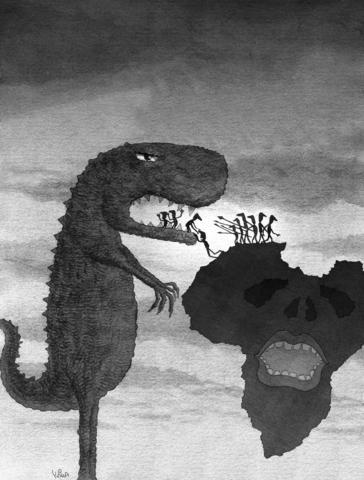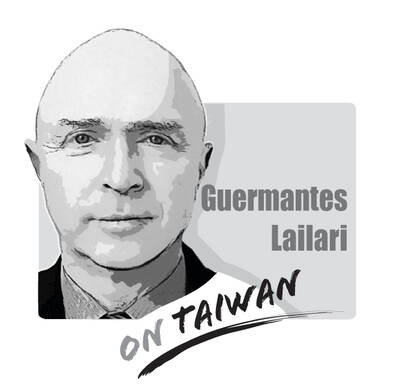The instant the sack of grain fell off the truck and thumped down on the ground, it was enveloped in a whirl of dust, fists and knees.
The crowd of hungry people, who had been baking for hours in the brutal heat at an emergency distribution center last Wednesday, were in no mood to negotiate. One man whipped out a 30cm long machete, another a dagger, a third a handgun, which he waved menacingly in the air.
"My food, my food, my food!" they all yelled, tussling over the sack.

It has been nine months since this country went through its biggest political change in 16 years, but surprisingly little has changed.
Hundreds of thousands of people are still on the verge of starvation, pirates still roam the seas, teenage gunmen still roam the streets and the promise of a functioning government remains a vapor.
The Transitional Federal Government of Somalia, a UN creation that was always considered a shaky, short-term compromise, was finally installed in Mogadishu, the capital, in December, but it, like many Somalis, is now teetering on the edge of survival. A raging insurgency has confined the government to a handful of heavily fortified buildings in Mogadishu, while the rest of the country suffers.
Jowhar, a town of donkey carts and dust storms about 80km north of Mogadishu, has been recently hit by a devastating mix of drought and floods, and a huge influx of needy people. The intensifying street fighting in Mogadishu has driven thousands from their homes and many showed up here, just when the local crops failed.
"There is nothing to eat," said Binti Olo Ahmad, 40, who trudged out of the capital two weeks ago with her eight children and now lives in a tent made from twigs and garbage bags. She laughed a short, throaty laugh when asked if the anarchy of the 1990s, when warring clans tore Somalia apart after the central government collapsed, were any worse.
"No way," she said. "I've never seen war like this."
UN officials are increasingly concerned. All the signs of a famine are on the horizon: food prices have nearly doubled in some areas, the cereal harvest was the worst in 13 years, malnutrition rates are sharply rising and the long-term forecast indicates that the rains this fall will be disappointing.
"Thousands of people are marching right up to the edge of a crisis," said Peter Goossens, the director of the World Food Program in Somalia. "Any additional little thing, any little flood or drought, will push them over."
The World Food Program is feeding 1.2 million people in Somalia, more than 15 percent of the population. Already, some people have starved.
"This poor country keeps taking one blow after another," Goossens said. "Ultimately, it will break."
Many Somalis feel that has already happened. A multimillion-dollar clan-reconciliation conference ended last month, and some elders later traveled to Saudi Arabia to sign a ceremonial agreement. But the myriad clans are still not at peace, and even the transitional government is showing worrying cracks.
Last week Prime Minister Ali Mohamed Gedi and President Abdullahi Yusuf Ahmed got into a standoff over whether some of Gedi's allies should face corruption charges. The two leaders are from rival clans, and some Somalis fear that unless the dispute is quickly resolved it could spell an end to the thin veneer of cooperation between the men and possibly turn into a clan war.
Government officials in Jowhar admit there are serious challenges. Ministries are not functioning, the transitional government is running out of money and all the recent turmoil has created overwhelming needs, said Hussein Hassan Mahamoud, the deputy governor in Jowhar.
"But we are trying," he said. "We just need time."
The question is this: How much time is there before the insurgency causes such serious divisions in the government that it falls apart?
Congratulations to China’s working class — they have officially entered the “Livestock Feed 2.0” era. While others are still researching how to achieve healthy and balanced diets, China has already evolved to the point where it does not matter whether you are actually eating food, as long as you can swallow it. There is no need for cooking, chewing or making decisions — just tear open a package, add some hot water and in a short three minutes you have something that can keep you alive for at least another six hours. This is not science fiction — it is reality.

A foreign colleague of mine asked me recently, “What is a safe distance from potential People’s Liberation Army (PLA) Rocket Force’s (PLARF) Taiwan targets?” This article will answer this question and help people living in Taiwan have a deeper understanding of the threat. Why is it important to understand PLA/PLARF targeting strategy? According to RAND analysis, the PLA’s “systems destruction warfare” focuses on crippling an adversary’s operational system by targeting its networks, especially leadership, command and control (C2) nodes, sensors, and information hubs. Admiral Samuel Paparo, commander of US Indo-Pacific Command, noted in his 15 May 2025 Sedona Forum keynote speech that, as
In a world increasingly defined by unpredictability, two actors stand out as islands of stability: Europe and Taiwan. One, a sprawling union of democracies, but under immense pressure, grappling with a geopolitical reality it was not originally designed for. The other, a vibrant, resilient democracy thriving as a technological global leader, but living under a growing existential threat. In response to rising uncertainties, they are both seeking resilience and learning to better position themselves. It is now time they recognize each other not just as partners of convenience, but as strategic and indispensable lifelines. The US, long seen as the anchor
Kinmen County’s political geography is provocative in and of itself. A pair of islets running up abreast the Chinese mainland, just 20 minutes by ferry from the Chinese city of Xiamen, Kinmen remains under the Taiwanese government’s control, after China’s failed invasion attempt in 1949. The provocative nature of Kinmen’s existence, along with the Matsu Islands off the coast of China’s Fuzhou City, has led to no shortage of outrageous takes and analyses in foreign media either fearmongering of a Chinese invasion or using these accidents of history to somehow understand Taiwan. Every few months a foreign reporter goes to